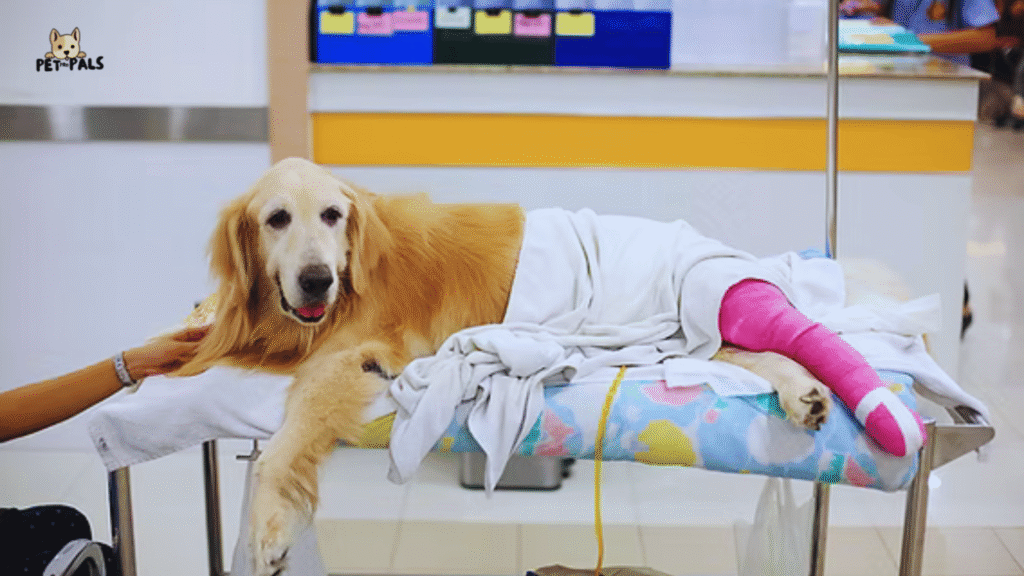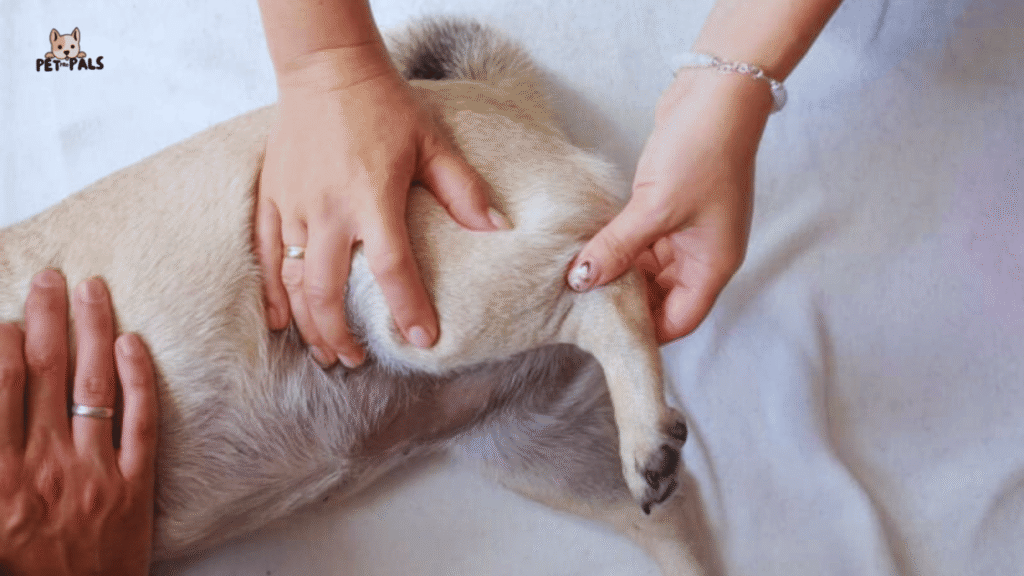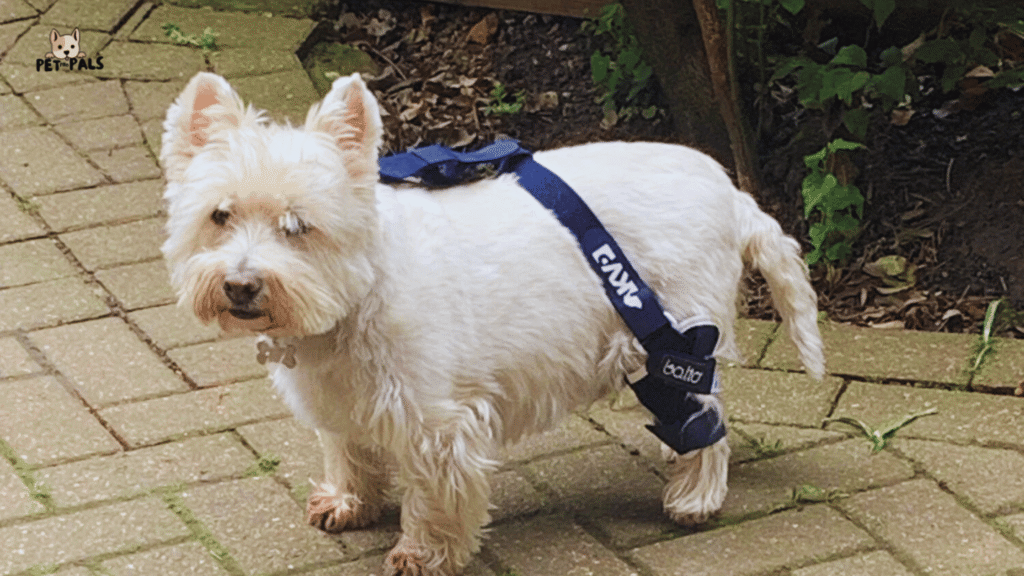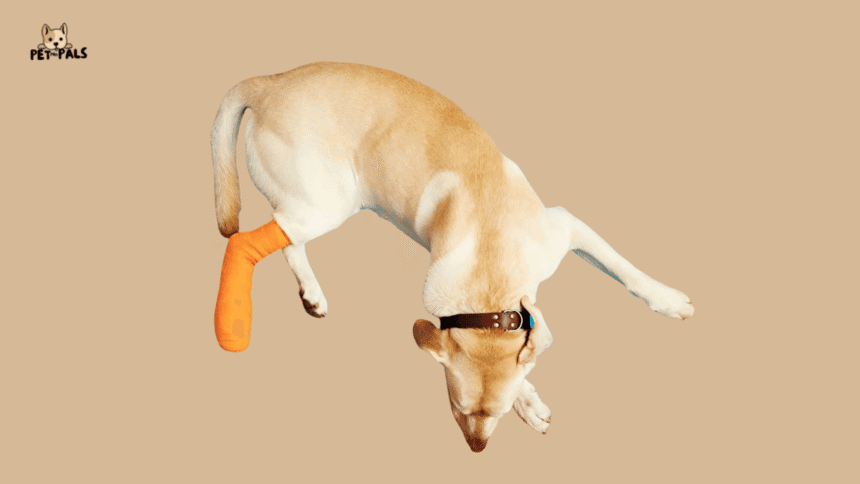Have you ever noticed your dog suddenly struggling to stand up or walk like they normally do? One minute, they’re running around like nothing’s wrong, and the next, their back legs seem wobbly, shaky, or even give out completely. It’s scary and understandably so.
Sudden hind leg weakness in dogs isn’t something you want to ignore. Like many other issues related to dog’s health, it can be minor or a warning sign of something more serious. Sometimes it’s just a temporary issue, like a sprain or overexertion.
But other times, it could be a red flag for something more serious, like a nerve problem, a slipped disc, or an underlying medical condition you weren’t even aware of. The truth is, there are quite a few possible reasons behind this kind of weakness, and knowing what to look for can make a huge difference.
That’s exactly what this guide is here to help with. We’re going to break down the most common causes of sudden back leg weakness in dogs, what symptoms you should watch for, and what steps you can take next. Whether your dog is a young pup or a senior with a few gray hairs, this kind of issue can show up without warning, and being informed is the first step toward helping them feel better.
What is Hind Leg Weakness in Dogs?

Hind leg weakness in dogs is exactly what it sounds like a sudden or gradual loss of strength, stability, or control in their back legs. It might show up as a limp, a wobble when they walk, or even full-on dragging of their hind legs. In some cases, your dog might struggle just to stand up or seem hesitant to walk at all.
This kind of weakness can come out of nowhere, which makes it all the more unsettling. One day your dog is chasing a ball like usual, and the next, they’re stumbling or collapsing in the back end. It’s not just a mobility issue it’s a signal that something’s not right under the surface.
While not every case is an emergency, some causes of hind leg weakness do need quick action. So if you notice these symptoms, don’t ignore them. The sooner you figure out what’s going on, the better chance you have of helping your dog recover and get back on their feet literally.
What Causes Sudden Hind Leg Weakness in Dogs?
There are several potential causes of sudden hind leg weakness in dogs. While some of these may be treatable with proper care, others may be more serious and require urgent veterinary attention. Here’s a quick overview of common causes:
- Injuries and Trauma
- Intervertebral Disc Disease (IVDD)
- Hip Dysplasia
- Degenerative Myelopathy (DM)
- Arthritis or Joint Disease
- Tick Paralysis
- Infections or Toxins
Now let’s dive deeper into each of these causes.
Common Causes of Hind Leg Weakness in Dogs

So, what’s going on when your dog’s back legs suddenly seem weak or unsteady? There isn’t just one answer. There are several common reasons behind this issue; some are relatively harmless and temporary, while others may point to something more serious.
Let’s walk through the most likely causes so you can start narrowing down what might be affecting your pup.
1. Injuries and Trauma
One of the most common causes of sudden leg weakness in dogs is injury. This could include sprains, fractures, or damage to soft tissues like muscles, tendons, or ligaments. If your dog has been active, running, or jumping, they might have injured themselves without you noticing right away.
When to Seek Help: If your dog is in pain, limping, or unable to move their leg properly, it’s important to see a vet right away. Severe pain or an inability to move the leg could indicate a fracture or a serious sprain.
2. Intervertebral Disc Disease (IVDD)
IVDD is a condition where one or more of the discs in your dog’s spine herniate, pressing on the spinal cord and causing weakness in the hind legs. This condition is especially common in breeds with long backs, like Dachshunds, Beagles, and Corgis.
Symptoms to Look For: Pain in the back, loss of coordination, or dragging of the hind legs can all indicate IVDD. If untreated, IVDD can progress to paralysis.
3. Hip Dysplasia
Hip dysplasia is a genetic condition where the hip joint doesn’t develop properly, leading to pain, instability, and eventually weakness in the hind legs. It’s especially common in large breeds like German Shepherds, Golden Retrievers, and Labradors.
Symptoms: Difficulty standing, limping, or reluctance to jump or run are all signs of hip dysplasia.
4. Degenerative Myelopathy (DM)
Degenerative Myelopathy is a progressive neurological condition that affects the spinal cord and causes gradual hind leg weakness. DM is more common in older dogs and can eventually lead to paralysis.
Symptoms: Initially, you might notice your dog stumbling, dragging their legs, or having trouble standing up. As the condition progresses, it may become harder for your dog to walk at all.
5. Arthritis or Joint Disease
Arthritis in dogs can lead to stiffness, pain, and weakness in the joints, particularly the hind legs. Dogs with arthritis may find it difficult to climb stairs or move comfortably.
Symptoms: If your dog seems stiff, hesitant to move, or reluctant to jump, they might be experiencing joint pain from arthritis.
6. Tick Paralysis
Tick paralysis is caused by a toxin in the saliva of certain ticks, which can lead to paralysis starting in the hind legs and spreading upwards. This condition can be fatal if not treated quickly.
Symptoms: Sudden weakness in the hind legs, which progresses to paralysis. If your dog is weak or unable to move their legs and has ticks on their body, this could be the cause.
7. Infections or Toxins
Certain infections, such as Lyme disease, or exposure to toxins (such as certain medications or plants) can cause weakness in the hind legs. These conditions are less common but should be considered, especially if your dog is also showing other signs like fever, loss of appetite, or joint pain.
Symptoms: Look out for fever, lethargy, loss of appetite, and pain in addition to the hind leg weakness.
Signs That Require Immediate Attention

While some causes of hind leg weakness might be minor or temporary, there are certain red flags you just shouldn’t wait on. If your dog shows any of the following symptoms, it’s time to get them to the vet—no second-guessing.
- Sudden and severe weakness in the hind legs
If your dog goes from walking normally to barely being able to stand or walk in a short amount of time, don’t wait it out. This kind of rapid change can be a sign of something serious, like a neurological issue or spinal injury. - Loss of coordination, tremors, or uncontrollable shaking
When your dog seems dizzy, disoriented, or can’t control their movements, it could point to a problem with their nervous system. These symptoms often go hand-in-hand with weakness in the back legs. - Inability to move or signs of paralysis
If your dog is dragging their back legs or can’t move them at all, it’s more than just weakness—that’s a full-blown emergency. This could mean nerve damage, a slipped disc, or even a spinal cord issue. - Intense pain or crying out when trying to move
Dogs are pretty tough, so if yours is yelping, whining, or visibly in pain when they try to stand, that’s a strong signal that something’s seriously wrong. Pain like this should always be checked out as soon as possible.
If your gut is telling you something isn’t right, trust it. It’s always better to be safe and have your vet rule out anything dangerous than to wait and risk things getting worse.
How a Vet Diagnoses the Cause of Hind Leg Weakness
When you visit the vet, they’ll begin with a physical exam, checking your dog’s mobility and pain levels. They might also recommend certain tests, such as X-rays, blood work, or a neurological exam, depending on the suspected cause. If the problem is related to a spinal issue, an MRI or CT scan might be necessary.
Treatment will depend on the diagnosis. It could range from surgery for conditions like IVDD or hip dysplasia to medication, physical therapy, or even alternative treatments like acupuncture.
How to Help Your Dog While Waiting for a Vet Appointment
We get it, waiting for a vet appointment when your dog is clearly struggling can feel frustrating and even a little helpless. But the good news is, there are a few simple things you can do at home to make your dog more comfortable and prevent things from getting worse in the meantime.
Manage Their Pain and Keep Them Comfortable
First things first, try to minimize your dog’s discomfort. If they seem sore or reluctant to move, create a cozy spot for them to rest. A soft dog bed, a warm blanket, or even a quiet corner of the house where they won’t be disturbed can go a long way. You’ll want to avoid any unnecessary movement that could aggravate the issue. And unless your vet has already advised you to give something for pain, it’s best not to offer any medication without guidance. Some human medications can be harmful to dogs.
Limit Their Activity
As much as your pup might want to follow you around the house, try to limit their movement for now. That means no running, jumping, or climbing if it can be avoided. Confine them to one room or a small area if needed to keep things calm and controlled. The goal is to avoid further strain until a vet can take a look.
Offer Gentle Support
If your dog needs to move around, maybe for bathroom breaks or getting in and out of the car, you can help them stay steady. A harness with a handle or a towel gently wrapped under their belly can provide some lift and balance. It might feel awkward at first, but most dogs appreciate the extra support when their legs aren’t cooperating.
Use Ramps or Non-Slip Surfaces
Slippery floors can be a nightmare for a dog with weak back legs. Try laying down yoga mats, rugs, or non-slip runners to give them more traction. And if stairs are part of your daily routine, consider using a ramp or carrying your dog if they’re small enough. It’s all about reducing the risk of a fall or further injury.
Keep Food, Water, and Essentials Within Reach
Make life a little easier by moving your dog’s food and water bowls closer to their resting spot. You want to make sure they’re staying hydrated and eating well, but without forcing them to walk across the house just to get to their bowls.
These small steps can make a big difference in keeping your dog safe and comfortable until your vet can assess the situation. The main thing is to stay calm and supportive—your dog will pick up on your energy, and just knowing you’re there makes a world of difference to them.
Preventive Measures to Keep Your Dog’s Legs Strong
While some causes of hind leg weakness can’t be prevented, there are steps you can take to reduce the risk:
- Weight Management: Keeping your dog at a healthy weight can reduce strain on their joints and prevent conditions like arthritis and hip dysplasia.
- Regular Exercise: Regular activity helps maintain muscle strength and joint flexibility, which can prevent stiffness.
- Supplements and Diet: Consider supplements like glucosamine, chondroitin, and omega-3 fatty acids, which are known to support joint health.
Conclusion
Sudden hind leg weakness in dogs can be frightening, but understanding the possible causes is the first step toward helping your pet recover. From injuries and arthritis to more serious conditions like IVDD or degenerative myelopathy, there are many reasons your dog might be struggling to walk.
The good news is that many of these issues are treatable or manageable with timely veterinary care. Keeping a close eye on symptoms and acting quickly can make a big difference in your dog’s recovery and comfort. Always consult your vet if you notice sudden changes in mobility. With the right support, treatment, and preventive care, your dog can maintain a good quality of life and continue enjoying the things they love most.
FAQs
Can older dogs suddenly develop hind leg weakness?
Yes, older dogs are more prone to age-related conditions like arthritis, degenerative myelopathy, or neurological issues that can lead to sudden leg weakness.
What breeds are most at risk for hind leg problems?
Breeds such as German Shepherds, Labradors, Dachshunds, and Corgis are more susceptible to hip dysplasia, IVDD, and degenerative conditions affecting the hind legs.
Is hind leg weakness in dogs always a sign of something serious?
Not always. It can range from minor injuries to serious neurological disorders. A vet visit is essential to determine the cause and appropriate treatment.
Can a dog recover from hind leg weakness?
Recovery depends on the cause. Some dogs improve with medication or rest, while others may need surgery or long-term management.
How can I support my dog at home if their back legs are weak?
Keep them comfortable, minimize stairs or jumping, use support harnesses if needed, and talk to your vet about supplements or therapy options.

